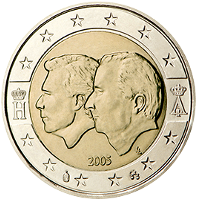 |
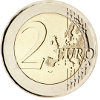 |
C o m m e m o r a t i v e
C o i n s |
||
| Belgium | |||||||
The edge lettering of the Belgian 2‐euro‐commemorative coins is : Different embossings are noted in the individual description. |
until 2017 :  |
||||||
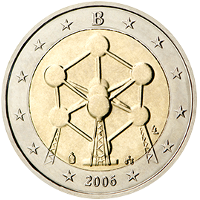 🔎
🔎 |
 |
Belgium | 10 Apr. 2006 | Renovation of the Atomium in Brussels |
20001 20002 20005 |
5,023,000 |  |
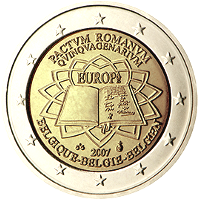 🔎
🔎 |
 |
Belgium | 26 Mar. 2007 | 50th anniversary of the Signature of the Treaty of Rome |
20001 20002 20005 |
5,040,000 |  |
National characteristics : At the top are the words "PACTVM ROMANVM" (Treaty of Rome) and "QVINQVAGENARIVM" (50 years), below it is an illustration of the treaty with the words "EUROPA/EUROPE", at the bottom the country name "BELGIQUE‐BELGIE‐BELGIEN" (in French, Dutch and German), above that is the year "2007" ‐ flanked on the left by a pair of scales the logo of mint master Romain Coenen, and on the right the helmeted head of the Archangel Michael the mint mark of the Royal Belgian mint Monnaie Royale de Belgique / Koninklijke Munt van België / Königliche Belgische Münzprägeanstalt in Brussels. |
|||||||
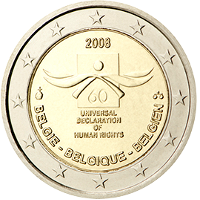 🔎
🔎 |
 |
Belgium | 30 May 2008 | 60th anniversary of the Universal Declaration of Human Rights |
20001 20002 20005 |
5,018,000 |  |
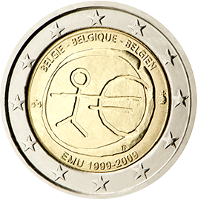 🔎
🔎 |
 |
Belgium | 27 Jan. 2009 | 10th anniversary of the Economic and Monetary Union (EMU) |
20001 20002 20005 |
5,012,000 |  |
National characteristics : Above is the name of the issuing country in the three national languages "BELGIE ‐ BELGIQUE ‐ BELGIE" (Dutch, French and German), the acronym of the occasion of issue below is "EMU". The motif is flanked on the left by a pair of scales the logo of mint master Romain Coenen, and on the right by the helmeted head of the Archangel Michael the mint mark of the Royal Belgian mint Monnaie Royale de Belgique / Koninklijke Munt van België / Königliche Belgische Münzprägeanstalt in Brussels. |
|||||||
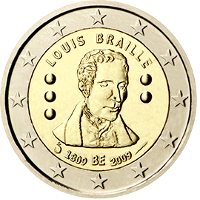 🔎
🔎 |
 |
Belgium | 25 Sep. 2009 | 200th birthday of Louis Braille |
20001 20002 20005 |
5,013,500 |  |
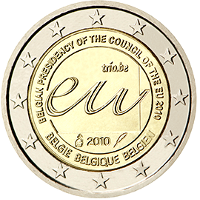 🔎
🔎 |
 |
Belgium | 11 Jun. 2010 | Belgian Presidency of the Council of the European Union |
20001 20002 20005 |
5,012,000 |  |
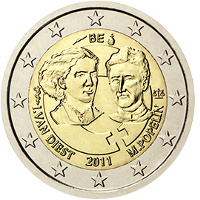 🔎
🔎 |
 |
Belgium | 03 May 2011 | 1st Centenary of the International Women's Day |
20001 20002 20005 |
5,013,500 |  |
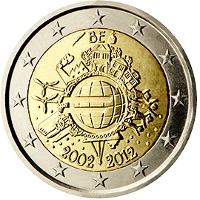 🔎
🔎 |
 |
Belgium | 30 Jan. 2012 | 10th anniversary of the Euro‐Currency |
20001 20002 20005 |
5,022,000 |  |
National characteristics : At the top of the coin is the abbreviation of the issuing country "BE" (Belgium), flanked on the left by a feather the logo of the mint master Serge Lesens and on the right by the mint mark of the Royal Belgian mint Monnaie Royale de Belgique / Koninklijke Munt van België / Königliche Belgische Münzprägeanstalt in Brussels, the helmeted head of the Archangel Michael. |
|||||||
 🔎
🔎 |
 |
Belgium | 06 Jun. 2012 | 75th anniversary of the Queen Elisabeth Music Competition |
20001 20002 20005 |
5,013,000 |  |
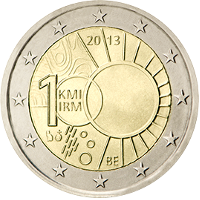 🔎
🔎 |
 |
Belgium | 18 Sep. 2013 | 100th anniversary of the creation of the Royal Meteorological Institute |
20001 20002 20005 |
2,010,000 |  |
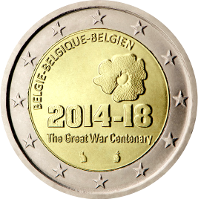 🔎
🔎 |
 |
Belgium | 12 May 2014 | 100th anniversary of the outbreak of the Great War |
20001 20002 20005 |
1,712,000 |  |
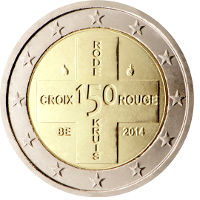 🔎
🔎 |
 |
Belgium | 18 Sep. 2014 | 150th anniversary of the Belgium Red Cross |
20001 20002 20005 |
287,500 |  |
 ) or
the Dutch version (GOD ⋆ ZIJ ⋆ MET ⋆ ONS ⋆) instead of the normal
Belgian edge inscription ( ) or
the Dutch version (GOD ⋆ ZIJ ⋆ MET ⋆ ONS ⋆) instead of the normal
Belgian edge inscription ( ). ). |
|||||||
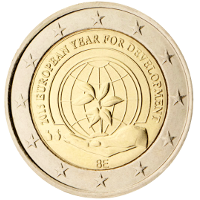 🔎
🔎 |
 |
Belgium | 17 Sep. 2015 | 2015 ‐ European Year for Development |
20001 20002 20005 |
250,000 |  |
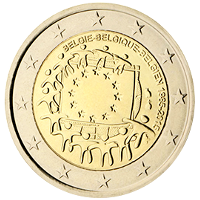 🔎
🔎 |
 |
Belgium | 18 Nov. 2015 | 30th anniversary of the EU‐Flag |
20001 20002 20005 |
412,500 |  |
National characteristics : Above is the name of the issuing country "BELGIE ‐ BELGIQUE ‐ BELGIEN" (in Dutch, French and German), followed by the dates "1985‐2015". A cat the logo of the mint master Bernard Gillard, as well as the helmeted head of the Archangel Michael the mint mark of the Royal Belgian mint Monnaie Royale de Belgique / Koninklijke Munt van België / Königliche Belgische Münzprägeanstalt in Brussels, are depicted on the right. |
|||||||
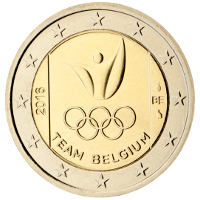 🔎
🔎 |
 |
Belgium | 24 Mar. 2016 | Olympic Summer Games 2016 - Team Belgium |
20001 20002 20005 |
375,000 |  |
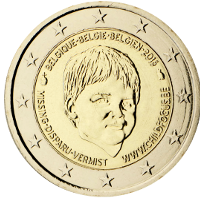 🔎
🔎 |
 |
Belgium | 25 May 2016 | International Missing Children's Day |
20001 20002 20005 |
1,020,000 |  |
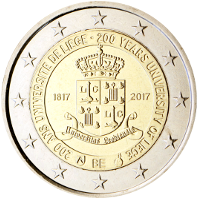 🔎
🔎 |
 |
Belgium | 21 Apr. 2017 | 200 anniversary University of Liège |
20001 20002 <20005 |
200,000 |  |
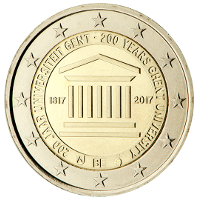 🔎
🔎 |
 |
Belgium | 29 Sep. 2017 | 200th anniversary of Ghent University |
20001 20002 20005 |
225,000 |  |
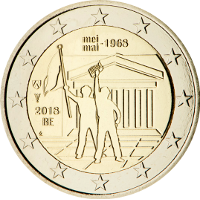 🔎
🔎 |
 |
Belgium | 19 Jun. 2018 | 50th anniversary of May 1968 events in Belgium |
20001 20002 20005 |
257,500 |  |
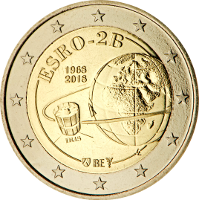 🔎
🔎 |
 |
Belgium | 20 Sep. 2018 | 50th anniversary of the launch of European satellite ESRO‐2B |
20001 20002 20005 |
257,500 |  |
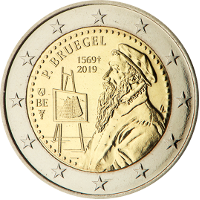 🔎
🔎 |
 |
Belgium | 24 Jan. 2019 | 450th anniversary of the death of Pieter Bruegel the Elder |
20001 20002 20005 |
155,000 |  |
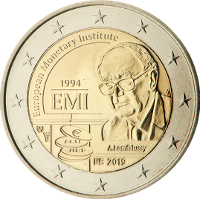 🔎
🔎 |
 |
Belgium | 09 May 2019 | 25th anniversary of the establishment of the European Monetary Institute |
20001 20002 20005 |
155,000 |  |
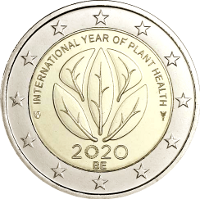 🔎
🔎 |
 |
Belgium | 05 Mar. 2020 | International year of plant health |
20002 20007 20008 |
755,000 |  |
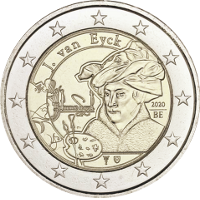 🔎
🔎 |
 |
Belgium | 15 Oct. 2020 | Jan van Eyck |
20002 20003 20005 |
155,000 |  |
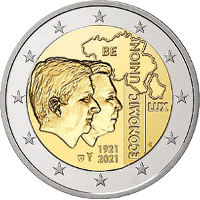 🔎
🔎 |
 |
Belgium | 07 Jul. 2021 | 100th anniversary of the Belgium‐Luxembourg Economic Union Treaty |
20002 20003 20005 |
155,000 |  |
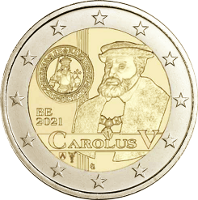 🔎
🔎 |
 |
Belgium | 27 Oct. 2021 | 500th anniversary of the issuance of the Carolus guilder |
20002 20007 20008 |
155,000 |  |
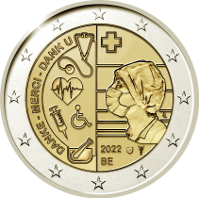 🔎
🔎 |
 |
Belgium | 17 May 2022 | Publicly funded health care |
20003 20005 |
155,000 |  |
 Work in progress |
|||||||
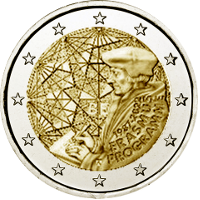 🔎
🔎 |
 |
Belgium | 01 Jul. 2022 | 35th anniversary of the Erasmus Program |
20003 20005 20009 |
1,000,000 |  |
National characteristics : The country abbreviation "BE" (Belgium) is placed centrally below the centre line. The quarter circle at the bottom right has three lines; below the commemorative period, the issue occasion "ERASMUS PROGRAMME". At the bottom on the left sleeve, the coat of arms of the municipality of Herzele is depicted on the left as the logo of mint master Ingrid Van Herzele, and to the right of it the staff of Hermes as the mint mark of the Royal Dutch mint Koninklijke Nederlandse Munt in Houten. The coin is one of those with a more textured background. |
|||||||
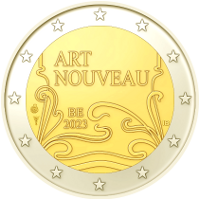 🔎
🔎 |
 |
Belgium | 20 Jun. 2023 | Year of Art Nouveau |
20003 20008 20009 |
155,000 |  |
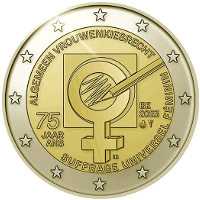 🔎
🔎 |
 |
Belgium | 25 Oct. 2023 | 75 Years of Women's Suffrage in Belgium |
20003 20005 |
130,000 |  |
 Work in progress |
|||||||
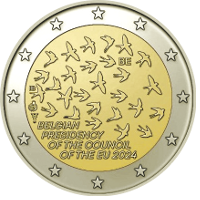
|
 |
Belgium | 15 Jan. 2024 | Belgian Presidency of the Council of the EU 2024 | 20003 | 155,000 |  |
 Work in progress |
|||||||
| References : | |||
| 20001 | Images taken with authorisation by the ECB ‐ Mail dated 20.Feb.2020 © "European Central Bank" |
20002 | Data mirrored from Wikipedia Page "2_euro_commemorative_coins" with friendly support of the guardians of that page. |
| 20003 | Images taken with authorisation by H....... Hamburg | 20004 | Coloured version of this Commemorative Coin in circulation EU‐legal‐technical specifications do not recongnise colour prints. The EU nevertheless tolerates them, as their numbers are very small and they are sold in special packs and therefor are very unlikely to be used as currency. |
| 20005 |
enlarged Images taken with authorisation by Gerd Seyffert © "Gerd Seyffert 2021" |
20006 | Not Applicable |
| 20007 | Images taken by Münzen Kreuzberg © "Münzen Kreuzberg 2021" |
20008 | enlarged Images taken by Münzen Kreuzberg © "Münzen Kreuzberg 2021" |
| 20009 | Text with kind permission by Gerd Seyffert © "Gerd Seyffert 2023" |
20010 | Not Applicable |
 |
